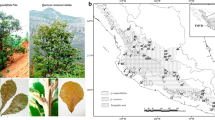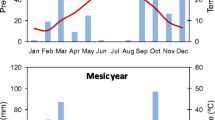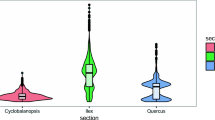Abstract
Differential selection pressures caused by environmental disparities lead to populations to become differentiated as they adapt to local environments. In addition, natural selection during the species past can contribute to the observed differentiation. In this study, we examine the geographic variation in a set of four traits related to growth and plant architecture in cork oak (Quercus suber) and investigate to what extent this variation is the result of the effects of ongoing evolution in current environments and the past evolutionary history of the species. Cork oak saplings at the common garden trial exhibited differences in plant architecture associated to cpDNA lineage. Eastern lineages, exhibited the lowest apical dominance and highest branchiness, consistent with the analyses in other cork oak trials. In contrast, patterns linked to the evolutionary past were less evident in height and diameter. These results suggest that selective pressures after cpDNA divergence can have blurred patterns in some traits closely related to fitness, while conserving the past evolutionary imprints in plant architectural traits. Introgressed populations did not show significant differentiation in architecture, which suggests that allele exchanges via hybridization have had a limited effect on population differentiation in cork oak. Finally, populations within lineages also showed differences in growth and architecture. Correlation between population architecture and temperature patterns were observed indicating that environmental factors such as climate also could result crucial in the evolution of plant architecture of cork oak within lineages.





Similar content being viewed by others
References
Alía R, Gil L, Pardos JA (1995) Performance of 43 Pinus pinaster provenances on 5 locations in Central Spain. Silvae Genet 44:75–81
Aranda I, Castro L, Alía R, Pardos JA, Gil L (2005) Low temperature during winter elicits differential responses among populations of the Mediterranean evergreen cork oak (Quercus suber). Tree Physiol 25:1085–1090
Aronson J, Pereira JS, Pausas JC (2009) Cork oak woodlands on edge: ecology, adaptive management and restoration. Island Press, Washington, DC
Barthélémy D, Caraglio Y (2007) Plant architecture: a dynamic, multilevel and comprehensive approach to plant form, structure and ontogeny. Ann Bot 99:375–407
Belahbib N, Pemonge MH, Ouassou A, Sbay H, Kremer A, Petit RJ (2001) Frequent cytoplasmic exchanges between oak species that are not closely related: Quercus suber and Q. ilex in Morocco. Mol Ecol 10:2003–2012
Bergin DO, Kimberley MO, Low CB (2008) Provenance variation in Podocarpus totara (D. Don): growth, tree form and wood density on a coastal site in the north of the natural range, New Zealand. For Ecol Manage 255:1367–1378
Bruschi P, Vendramin GG, Bussotti F, Grossoni P (2003) Morphological and molecular diversity among Italian populations of Quercus petraea (Fagaceae). Ann Bot 91:707–716
Burgarella C, Lorenzo Z, Jabbour-Zahab R, Lumaret R, Guichoux E, Petit RJ, Soto A, Gil L (2009) Detection of hybrids in nature: application to oaks (Quercus suber and Q. ilex). Heredity 102:442–452
Cavender-Bares J, Pahlich A (2009) Molecular, morphological and ecological niche differentiation of sympatric sister oak species, Quercus virginiana and Q. geminata (Fagaceae). Am J Bot 96:1690–1702
Comstock JP (2000) Variation in hydraulic architecture and gas- exchange in two desert sub-shrubs, Hymenoclea salsola (T. & G.) and Ambrosia dumosa (Payne). Oecologia 125:1–10
Cundall EP, Cahalan CM, Connolly T (2003) Early results of ash (Fraxinus excelsior L.) provenance trials at sites in England and Wales. Forestry 76:385–399
Denk T, Grimm GW, Hemleben V (2005) Patterns of molecular and morphological differentiation in Fagus (Fagaceae): phylogenetic implications. Am J Bot 92:1006–1016
Donovan LA, Dudley SA, Rosenthal DM, Ludwig F (2007) Phenotypic selection on leaf water use efficiency and related ecophysiological traits for natural populations of desert sunflowers. Oecologia 152:13–25
Foster SA, McKinnon GE, Steane DA, Potts BM, Vaillancourt RE (2007) Parallel evolution of dwarf ecotypes in the forest tree Eucalyptus globulus. New Phytol 175:370–380
Gandour M, Khouja ML, Toumi L, Triki S (2007) Morphological evaluation of cork oak (Quercus suber L.): Mediterranean provenance variability in Tunisia. Ann For Sci 64:549–555
Gonzalez-Martinez SC, Alia R, Gil L (2002) Population genetic structure in a Mediterranean pine (Pinus pinaster Ait.): a comparison of allozyme markers and quantitative traits. Heredity 89:199–206
Hatziskakis S, Tsiripidis I, Papageorgiou AC (2011) Leaf morphological variation in beech (Fagus sylvatica L.) populations in Greece and its relation to their post-glacial origin. Bot J Linn Soc 165:422–436
Hewitt GM (1996) Some genetic consequences of ice ages, and their role in divergence and speciation. Biol J Linn Soc 58:247–276
Housman DC, Price MV, Redak RA (2002) Architecture of coastal and desert Encelia farinosa (Asteraceae): consequences of plastic and heritable variation in leaf characters. Am J Bot 89:1303–1310
Jiménez P, López de Heredia U, Collada C, Lorenzo Z, Gil L (2004) High varaiability of chloroplast DNA in three Mediterranean evergreen oaks indicates complex evolutionary history. Heredity 93:510–515
Körrner Ch, Cochrane P (1983) Influence of plant physiognomy on leaf temperature on clear midsummer days in the Snowy Mountains, south-eastern Australia. Acta Oecol, Oecol Plant 4:117–124
Kremer A, Kleinschmit J, Cottrell J, Cundall EP, Deans JD, Ducousso A, König AO, Lowe AJ, Munro RC, Petit RJ, Stephan BR (2002) Is there a correlation between chloroplastic and nuclear divergence, or what are the roles of history and selection on genetic diversity in European oaks? For Ecol Manage 156:75–85
Leinonen T, O’Hara RB, Cano JM, Merila J (2008) Comparative studies of quantitative trait and neutral marker divergence: a meta-analysis. J Evol Biol 21:1–17
Linares JC (2011) Biogeography and evolution of Abies (Pinaceae) in the Mediterranean Basin: the roles of long-term climatic change and glacial refugia. J Biogeogr 38:619–630
López de Heredia U (2006) La diversidad en las especies forestales: un cambio de escala. El ejemplo del alcornoque. Ecosistemas 15:24–33
López de Heredia U, Jiménez P, Díaz-Fernández P, Gil L (2005) The Balearic islands: a reservoir of cpDNA genetic variation for evergreen oaks. J Biogeogr 32:939–949
López de Heredia U, Carrión JS, Jiménez P, Collada C, Gil L (2007a) Molecular and palaeobotanical evidence for multiple glacial refugia for evergreen oaks on the Iberian Peninsula. J Biogeogr 34:1505–1517
López de Heredia UL, Jiménez P, Collada C, Simeone MC, Bellarosa R, Schirone B, Cervera MT, Gil L (2007b) Multi-marker phylogeny of three evergreen oaks reveals vicariant patterns in the Western Mediterranean. Taxon 56:1209–1220
Lumaret R, Jabbour-Zahab R (2009) Ancient and current gene flow between two distantly related Mediterranean oak species, Quercus suber and Q. ilex. Ann Bot 104:725–736
Lumaret R, Mir C, Michaud H, Raynal V (2002) Phylogeographical variation of chloroplast DNA in holm oak (Quercus ilex L.). Mol Ecol 11:2327–2336
Lumaret R, Tryphon-Dionnet M, Michaud H, Sanuy A, Ipotesi E, Born C, Mir C (2005) Phylogeographical variation of chloroplast DNA in cork oak (Quercus suber). Ann Bot 96:853–861
Magri D, Fineschi S, Bellarosa R, Buonamici A, Sebastiani F, Schirone B, Simeone MC, Vendramin GG (2007) The distribution of Quercus suber chloroplast haplotypes matches the palaeogeographical history of the western Mediterranean. Mol Ecol 16:5259–5266
Mallet J (2007) Hybrid speciation. Nature 446:279–283
Merilä J, Crnokrak P (2001) Comparison of genetic differentiation at marker loci and quantitative traits. J Evol Biol 14:892–903
Mir C, Toumi L, Jarne P, Sarda V, Di Giusto F, Lumaret R (2006) Endemic North African Quercus afares Pomel originates from hybridisation between two genetically very distant oak species (Q. suber L. and Q. canariensis Willd.): evidence from nuclear and cytoplasmic markers. Heredity 96:175–184
Ortego J, Bonal R (2010) Natural hybridisation between kermes (Quercus coccifera, L.) and holm oaks (Q. ilex, L.) revealed by microsatellite markers. Plant Biol 12:234–238
Papageorgiou AC, Vidalis A, Gailing O, Tsiripidis I, Hatziskakis S, Boutsios S, Galatsidas S, Finkeldey R (2008) Genetic variation of beech (Fagus sylvatica L.) in Rodopi (N.E. Greece). Eur J For Res 127:81–88
Pearcy RW, Valladares F, Wright SJ, Lasso E (2004) A functional analysis of the crown architecture of tropical forest Psychotria species: do species vary in light capture efficiency and consequently in carbon gain and growth? Oecologia 139:163–167
Petit RJ, Brewer S, Bordacs S, Burg K, Cheddadi R, Coart E, Cottrell J, Csaikl UM, van Dam B, Deans JD, Espinel S, Fineschi S, Finkeldey R, Glaz I, Goicoechea PG, Jensen JS, Konig AO, Lowe AJ, Madsen SF, Matyas G, Munro RC, Popescu F, Slade D, Tabbener H, Vries SGM, Ziegenhagen B, Beaulieu JL, Kremer A (2002) Identification of refugia and post-glacial colonisation routes of European white oaks based on chloroplast DNA and fossil pollen evidence. For Ecol Manage 156:49–74
Petit RJ, Bodenes C, Ducousso A, Roussel G, Kremer A (2004) Hybridization as a mechanism of invasion in oaks. New Phytol 161:151–154
Petit RJ, Duminil J, Fineschi S et al (2005) Comparative organization of chloroplast, mitochondrial and nuclear diversity in plant populations. Mol Ecol 14:689–701
Ramírez-Valiente JA, Valladares F, Gil L, Aranda I (2009a) Population differences in juvenile survival under increasing drought are mediated by seed size in cork oak (Quercus suber L.). For Ecol Manage 257:1676–1683
Ramírez-Valiente JA, Lorenzo Z, Soto A, Valladares F, Gil L, Aranda I (2009b) Elucidating the role of genetic drift and natural selection in cork oak differentiation regarding drought tolerance. Mol Ecol 18:3803–3815
Ramírez-Valiente JA et al (2010) Phenotypic plasticity and local adaptation in leaf ecophysiological traits of 13 contrasting cork oak populations under different water availabilities. Tree Physiol 30:618–627
Ramírez-Valiente JA, Valladares F, Delgado A, Granados S, Aranda I (2011) Factors affecting cork oak growth under dry conditions: local adaptation and contrasting additive genetic variance within populations. Tree Genet Genome 7:285–295
Rieseberg LH, Wendel J (1993) Introgression and its consequences in plants. In: Harrison R (ed) Hybrid Zones and the Evolutionary Process. Oxford University Press, New York
Scotti-Saintagne C, Mariette S, Porth I, Goicoechea PG, Barreneche T, Bodenes C, Burg K, Kremer A (2004) Genome scanning for interspecific differentiation between two closely related oak species [Quercus robur L. and Q. petraea (Matt.) Liebl.]. Genetics 168:1615–1626
Seehausen O (2004) Hybridization and adaptive radiation. Trends Ecol Evol 19:198–207
Soto A, Lorenzo ZR, Gil L (2007) Differences in fine-scale genetic structure and dispersal in Quercus ilex L. and Q. suber L.: consequences for regeneration of Mediterranean open woods. Heredity 99:601–607
Svenning JC, Skov F (2005) The relative roles of environment and history as controls of tree species composition and richness in Europe. J Biogeogr 32:1019–1033
Toumi L, Lumaret R (1998) Allozyme variation in cork oak (Quercus suber L): the role of phylogeography, genetic introgression by other Mediterranean oak species and human activities. Theor Appl Genet 97:647–656
Valbuena-Carabaña M, González-Martínez SC, Hardy OJ, Gil L (2007) Fine-scale spatial genetic structure in mixed oak stands with different levels of hybridization. Mol Ecol 16:1207–1219
Wang Y, Li J (2005) Genes controlling plant architecture. Curr Opin Biotechnol 17:1–7
Wang Y, Li J (2008) Molecular basis of plant architecture. Ann Rev Plant Biol 59:253–279
White TL, Adams WT, Neale DB (2007) Forest genetics. CAB International, Wallingford, UK
Willyard A, Cronn R, Liston A (2009) Reticulate evolution and incomplete lineage sorting among the ponderosa pines. Mol Phylogenet Evol 52:498–511
Acknowledgments
We are grateful to Pedro Fernández, Laura Castro, Regina Chambel, José María Climent, Pilar Jiménez, and everyone from the Forestry School of Madrid who collaborated in the setting up of the cork oak common gardens under the EU-concerted action on cork oak, FAIR I CT 95 0202. We would like to thank Salustiano Iglesias and the DGB for the maintenance of the assays. We also thank Santiago de Blas, José Antonio Mancha, Diana Barba, Fernando del Caño and other field assistants for their help during the experiment. This work was funded by the Spanish Ministry of Science (PLASTOFOR, AGL-00536/FOR and and AGL2011-25365/FOR projects). This study was also supported by a González-Esparcia postdoctoral scholarship to JARV.
Author information
Authors and Affiliations
Corresponding author
Electronic supplementary material
Below is the link to the electronic supplementary material.
Rights and permissions
About this article
Cite this article
Ramírez-Valiente, J.A., Alia, R. & Aranda, I. Geographical variation in growth form traits in Quercus suber and its relation to population evolutionary history. Evol Ecol 28, 55–68 (2014). https://doi.org/10.1007/s10682-013-9660-0
Received:
Accepted:
Published:
Issue Date:
DOI: https://doi.org/10.1007/s10682-013-9660-0




